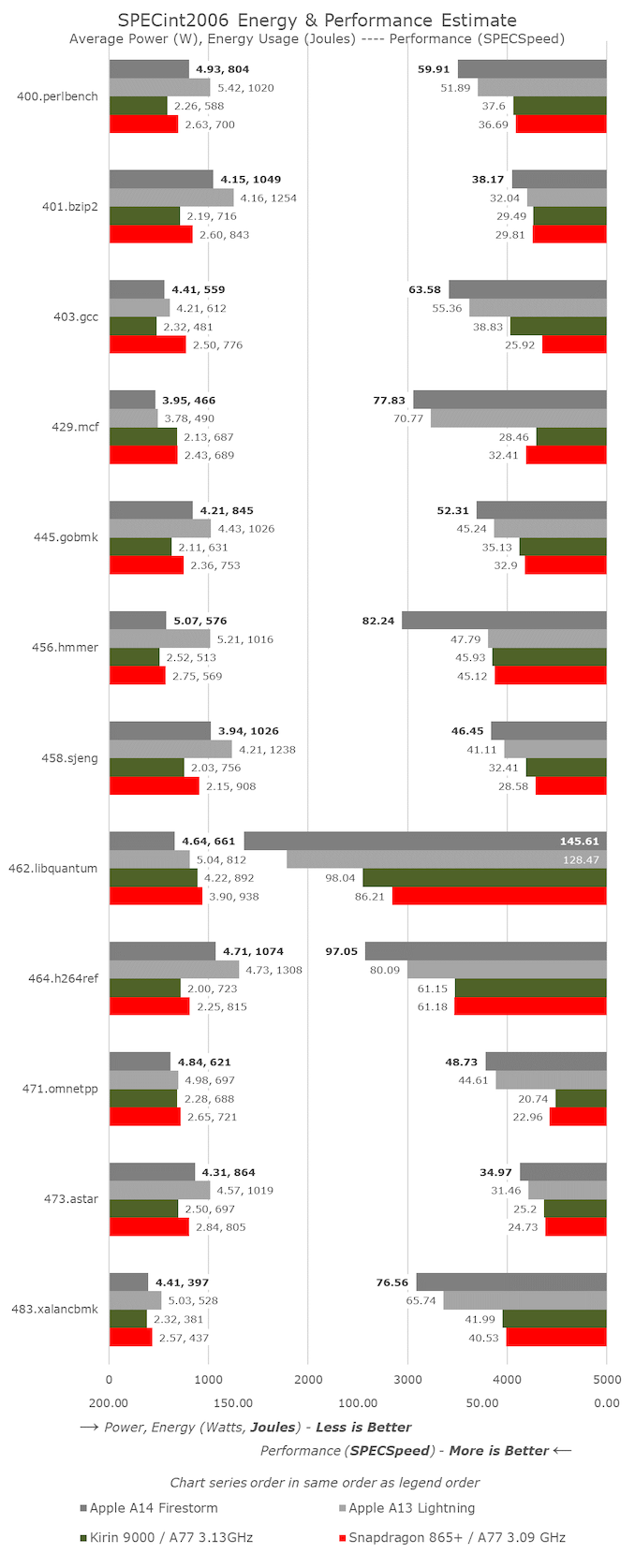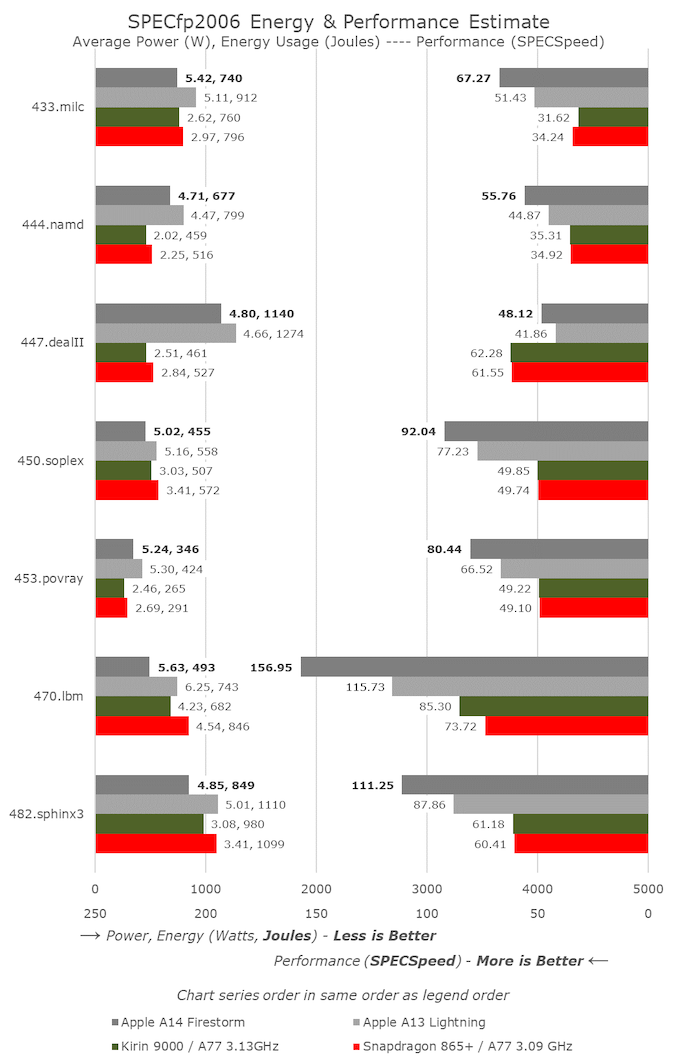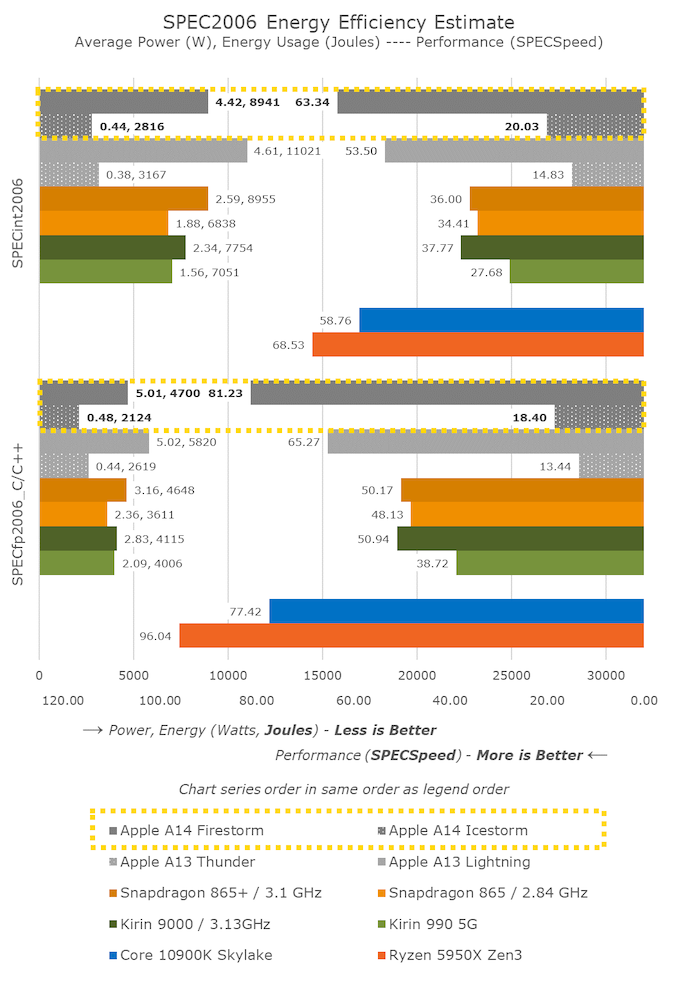Apple Announces The Apple Silicon M1: Ditching x86 - What to Expect, Based on A14
by Andrei Frumusanu on November 10, 2020 3:00 PM EST- Posted in
- Apple
- Apple A14
- Apple Silicon
- Apple M1
Dominating Mobile Performance
Before we dig deeper into the x86 vs Apple Silicon debate, it would be useful to look into more detail how the A14 Firestorm cores have improved upon the A13 Lightning cores, as well as detail the power and power efficiency improvements of the new chip’s 5nm process node.
The process node is actually quite the wildcard in the comparisons here as the A14 is the first 5nm chipset on the market, closely followed by Huawei’s Kirin 9000 in the Mate 40 series. We happen to have both devices and chips in house for testing, and contrasting the Kirin 9000 (Cortex-A77 3.13GHz on N5) vs the Snapdragon 865+ (Cortex-A77 3.09GHz on N7P) we can somewhat deduct how much of an impact the process node has in terms of power and efficiency, translating those improvements to the A13 vs A14 comparison.
Starting off with SPECint2006, we don’t see anything very unusual about the A14 scores, save the great improvement in 456.hmmer. Actually, this wasn’t due to a microarchitectural jump, but rather due to new optimisations on the part of the new LLVM version in Xcode 12. It seems here that the compiler has employed a similar loop optimisation as found on GCC8 onwards. The A13 score actually had improved from 47.79 to 64.87, but I hadn’t run new numbers on the whole suite yet.
For the rest of the workloads, the A14 generally looks like a relatively linear progression from the A13 in terms of progression, accounting for the clock frequency increase from 2.66GHz to 3GHz. The overall IPC gains for the suite look to be around 5% which is a bit less than Apple’s prior generations, though with a larger than usual clock speed increase.
Power consumption for the new chip is actually in line, and sometimes even better than the A13, which means that workload energy efficiency this generation has seen a noticeable improvement even at the peak performance point.
Performance against the contemporary Android and Cortex-core powered SoCs looks to be quite lopsided in favour of Apple. The one thing that stands out the most are the memory-intensive, sparse memory characterised workloads such as 429.mcf and 471.omnetpp where the Apple design features well over twice the performance, even though all the chip is running similar mobile-grade LPDDR4X/LPDDR5 memory. In our microarchitectural investigations we’ve seen signs of “memory magic” on Apple’s designs, where we might believe they’re using some sort of pointer-chase prefetching mechanism.
In SPECfp, the increases of the A14 over the A13 are a little higher than the linear clock frequency increase, as we’re measuring an overall 10-11% IPC uplift here. This isn’t too surprising given the additional fourth FP/SIMD pipeline of the design, whereas the integer side of the core has remained relatively unchanged compared to the A13.
In the overall mobile comparison, we can see that the new A14 has made robust progress in terms of increasing performance over the A13. Compared to the competition, Apple is well ahead of the pack – we’ll have to wait for next year’s Cortex-X1 devices to see the gap narrow again.
What’s also very important to note here is that Apple has achieved this all whilst remaining flat, or even lowering the power consumption of the new chip, notably reducing energy consumption for the same workloads.
Looking at the Kirin 9000 vs the Snapdragon 865+, we’re seeing a 10% reduction in power at relatively similar performance. Both chips use the same CPU IP, only differing in their process node and implementations. It seems Apple’s A14 here has been able to achieve better figures than just the process node improvement, which is expected given that it’s a new microarchitecture design as well.
One further note is the data of the A14’s small efficiency cores. This generation we saw a large microarchitectural boost on the part of these new cores which are now seeing 35% better performance versus last year’s A13 efficiency cores – all while further reducing energy consumption. I don’t know how the small cores will come into play on Apple’s “Apple Silicon” Mac designs, but they’re certainly still very performant and extremely efficient compared to other current contemporary Arm designs.
Lastly, there’s the x86 vs Apple performance comparison. Usually for iPhone reviews I comment on this in this section of the article, but given today’s context and the goals Apple has made for Apple Silicon, let’s investigate that into a whole dedicated section…













644 Comments
View All Comments
sonny73n - Saturday, November 14, 2020 - link
We all know Apple is always BS. Somehow their BS always work on some people.Alej - Saturday, November 14, 2020 - link
@sonny73n: really man, who is ‘we all’? That doesn’t include the andand tech writers for sure in that ‘all’. They didn’t find this BS.But alright, fine, let’s not listen to Apple, let’s listen to anybody else NON-Apple: check the leaked M1 benchmarks, single core and multi core through the roof. Integrated GPU compute scores on par with discrete Radeon 580X. Octane X GPU renderer devs stating that they can fit scenes with 100+GB worth of textures in those 16GB UMA. Affinity Photo devs saying that they have increase several fold the equivalent tier from previous generation. DaVinci Resolve having 5x in some parts of their editing. (Again these are not Apple’s statements).
Will it beat the latest RTX cards? Of course not... in the same sense that the latest RTX power hungry constantly thermal throttled crazy heavy laptops won’t last the 20hrs a MacBook Pro M1 can. The two at aiming at different goals.
Also, all the ‘general purpose’ or ‘not general purpose’ comparison or chit chat... what the heck is that coming from. I’m just a normal user, I boot my machine and launch ANY GENERAL PURPOSE program... and it runs faster, better, leaner, quieter; but then I’ll complain? “fine, but it’s maybe not general purpose so I’ll go to these other systems that do exactly the same but slower, but hey, they are REAL general purpose”.
Excuse me the rant vibe, I understand there’s the blind sheep Apple following and the gratuitously apple haters. There’s a middle ground, just look at the numbers for the fun of it... and actually, maybe even don’t if the device wouldn’t even be something to be considered for purchase. You know why I never go around Lamborghini shops bashing or criticizing their cars? Because I’m honestly not interested in buying one.
novastar78 - Wednesday, November 11, 2020 - link
You got man!The question I have it, can it run Crysis?
This is all just Apple fan boys getting worked up. I'll most likely never own an Apple product so for us old guys this is just fluff.
Its just an ARM chip with a PowerVR GPU (that they stole). Not seeing the big deal here except for the Appleites
Spunjji - Thursday, November 12, 2020 - link
@novastar78 - "Its just an ARM chip with a PowerVR GPU (that they stole). Not seeing the big deal here except for the Appleites"One of the world's most popular and influential computer manufacturers is producing an ARM-based chip that beats the pants off Intel's best in terms of power-efficiency *and* performance, and slaps AMD around for power... and that's NBD to you? Okay. I guess you're just not that interested in tech 🤷♂️
vais - Friday, November 13, 2020 - link
@Spunjji - three times hurray for jumping to conclusions! But it's not really your fault, the benchmarks don't say they are only single threaded... M1 will absolutely be more power efficient than both Intel and AMD - but to have more performance total, when all are running all cores at normal power? People's daydreams will be shattered when real benchmark results are released.star-affinity - Friday, November 13, 2020 - link
@vaishttps://browser.geekbench.com/v5/cpu/4648107
Daydream?
vais - Friday, November 13, 2020 - link
I'm not convinced by geekbench results. If we look there, Snapdragon 865 is half the single-core performance of 5900X.If that was true and actually translated to real world performance, a lot of services would have transitioned to those fabled ARM chips.
Spunjji - Friday, November 13, 2020 - link
@vais - "If that was true and actually translated to real world performance, a lot of services would have transitioned to those fabled ARM chips" - have you even paid attention to what's happening with Graviton?https://www.anandtech.com/show/15578/cloud-clash-a...
Alej - Saturday, November 14, 2020 - link
@Spunjji just wanted to chime in as I have noted the effort at keeping it all quiet and factual. Not jumping to hasty conclusions and pointing out facts/numbers where available. I was already convinced but even got extra pointers out of the sometimes out of whack discussions.Hats off, that’s hard work.
GeoffreyA - Sunday, November 15, 2020 - link
100%. Spunjji is always bringing sense and sanity back to conversations, and he's critical and objective. I always look forward to his comments.